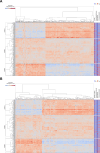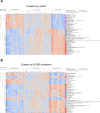Molecular characterisation of lupus low disease activity state (LLDAS) and DORIS remission by whole-blood transcriptome-based pathways in a pan-European systemic lupus erythematosus cohort
- PMID: 38373843
- PMCID: PMC11187369
- DOI: 10.1136/ard-2023-224795
Molecular characterisation of lupus low disease activity state (LLDAS) and DORIS remission by whole-blood transcriptome-based pathways in a pan-European systemic lupus erythematosus cohort
Abstract
Objectives: To unveil biological milieus underlying low disease activity (LDA) and remission versus active systemic lupus erythematosus (SLE).
Methods: We determined differentially expressed pathways (DEPs) in SLE patients from the PRECISESADS project (NTC02890121) stratified into patients fulfilling and not fulfilling the criteria of (1) Lupus LDA State (LLDAS), (2) Definitions of Remission in SLE remission, and (3) LLDAS exclusive of remission.
Results: We analysed data from 321 patients; 40.8% were in LLDAS, and 17.4% in DORIS remission. After exclusion of patients in remission, 28.3% were in LLDAS. Overall, 604 pathways differed significantly in LLDAS versus non-LLDAS patients with an false-discovery rate-corrected p (q)<0.05 and a robust effect size (dr)≥0.36. Accordingly, 288 pathways differed significantly between DORIS remitters and non-remitters (q<0.05 and dr≥0.36). DEPs yielded distinct molecular clusters characterised by differential serological, musculoskeletal, and renal activity. Analysis of partially overlapping samples showed no DEPs between LLDAS and DORIS remission. Drug repurposing potentiality for treating SLE was unveiled, as were important pathways underlying active SLE whose modulation could aid attainment of LLDAS/remission, including toll-like receptor (TLR) cascades, Bruton tyrosine kinase (BTK) activity, the cytotoxic T lymphocyte antigen 4 (CTLA-4)-related inhibitory signalling, and the nucleotide-binding oligomerization domain leucine-rich repeat-containing protein 3 (NLRP3) inflammasome pathway.
Conclusions: We demonstrated for the first time molecular signalling pathways distinguishing LLDAS/remission from active SLE. LLDAS/remission was associated with reversal of biological processes related to SLE pathogenesis and specific clinical manifestations. DEP clustering by remission better grouped patients compared with LLDAS, substantiating remission as the ultimate treatment goal in SLE; however, the lack of substantial pathway differentiation between the two states justifies LLDAS as an acceptable goal from a biological perspective.
Keywords: Autoimmune Diseases; Autoimmunity; Immune System Diseases; Lupus Erythematosus, Systemic; Outcome Assessment, Health Care.
© Author(s) (or their employer(s)) 2024. Re-use permitted under CC BY-NC. No commercial re-use. See rights and permissions. Published by BMJ.
Conflict of interest statement
Competing interests: IP has received research funding and/or honoraria from Amgen, AstraZeneca, Aurinia, Elli Lilly, Gilead, GlaxoSmithKline, Janssen, Novartis, Otsuka, and Roche.
Figures





